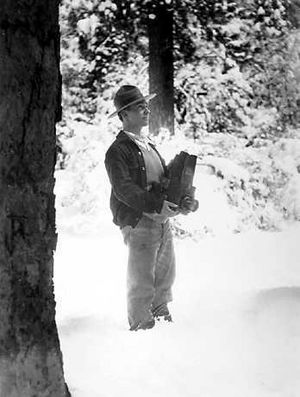Hispanic Heritage Sites facts for kids
The National Park System helps us remember the amazing things Hispanic people have done for American society. About 20 national parks show off Hispanic heritage in the United States. These parks don't just protect history; they are also part of the nation's story. The National Park Service has always changed with the country. Many Hispanic individuals have played a big part in shaping these parks.
Contents
Important Hispanic Leaders in the Parks
Many Hispanic individuals have helped shape the National Park Service. They have worked as scientists, park leaders, and in other important roles.
George Melendez Wright: A Visionary Biologist
George Melendez Wright was born in California in 1904. In 1927, he started working at Yosemite National Park. He was an assistant park naturalist. Through his studies, he helped the park service change its approach. Instead of harming predators, he promoted scientific ways to manage park plants, animals, and scenery. His ideas helped protect nature in a better way.
- Learn more about George Wright: George Wright Society
- Read his book: Fauna of the National Parks of the United States
Hispanic Park Superintendents
Many Hispanic leaders have served as superintendents of national parks. These are the people who manage and run the parks every day. Some of these early leaders include:
- Julio Marrero-Nunez (San Juan, 1962–1970)
- Edward C. Rodriquez, Jr. (Organ Pipe Cactus, 1973–1975)
- Ray G. Martinez, Jr. (Organ Pipe Cactus, 1975–1979)
- Ernest W. Ortega (Pecos, 1978–1980)
- José A. Cisneros (San Antonio Missions, 1979–1988)
- Santiago Cruz (San Juan, 1980)
- Luis Garcia-Curbelo (San Juan, 1980–1985)
- Robert C. Reyes (Florissant Fossil Beds, 1980–1983)
- David P. Herrerra (Whitman Mission, 1987–1990)
- Eddie L. Lopez (Grant-Kohrs Ranch, 1988 – c. 1993)
- Vidal V. Martinez (Sagamore Hill, 1990 – c. 1993)
Hispanic Regional Directors
Hispanic leaders have also held very high positions, like Regional Directors. These directors oversee many parks in a large area.
- Ernesto Quintana was a Regional Director for the Midwest Region starting in 2003.
National Parks Showing Hispanic Heritage
Many national park sites across the United States celebrate Hispanic history and culture. These parks tell stories of explorers, settlers, and important events.
Parks in the Caribbean and Florida
- Christiansted National Historic Site in Christiansted, United States Virgin Islands. This site is on Saint Croix, one of the Caribbean islands. Christopher Columbus visited this area long ago.
- Castillo de San Marcos National Monument in St. Augustine, Florida. The Spanish started building this fort in 1672. It is the oldest masonry fort in the continental United States. It protected St. Augustine, which was the first permanent European settlement in the U.S.
- De Soto National Memorial in Bradenton, Florida. This park remembers when Spanish explorer Hernando de Soto landed here in 1539. His journey was the first big European exploration of the southern United States.
- Fort Matanzas National Monument in St. Augustine, Florida. The Spanish built this fort between 1740 and 1742. Its purpose was to warn St. Augustine if British or other enemies were coming from the south.
- Gulf Islands National Seashore in Gulf Breeze, Florida. This area has beautiful beaches and historic forts, including the Bateria de San Antonio.
- Dry Tortugas National Park is also in Florida. It is known for its remote islands and historic fort.
- Salt River Bay National Historical Park and Ecological Preserve is in the U.S. Virgin Islands. It protects both historical and natural areas.
- San Juan National Historic Site in San Juan, Puerto Rico. These strong stone forts are the oldest in the U.S. territories. The Spanish started building them in the 1500s. They protected a key harbor that was important for ships traveling to the New World.
Parks in the Southwest and West
- Cabrillo National Monument in San Diego, California. This monument honors Juan Rodríguez Cabrillo. He was a Portuguese explorer who claimed the West Coast of the United States for Spain in 1542.
- Chamizal National Memorial in El Paso, Texas. This park celebrates a peaceful agreement. It settled a 99-year border dispute between the United States and Mexico. The park also hosts cultural events like drama, dance, and music.
- Coronado National Memorial in Hereford, Arizona. This site marks where Francisco Vásquez de Coronado's expedition entered the U.S. in 1540. It was the first European exploration of the Southwest.
- El Morro National Monument in Ramah, New Mexico. This park has "Inscription Rock," a large sandstone rock. Hundreds of carvings are on it, including those made by Spanish explorers and settlers.
- Juan Bautista de Anza National Historic Trail follows the route of a Spanish explorer.
- Padre Island National Seashore in Texas is a long barrier island.
- Palo Alto Battlefield National Historical Park in Texas tells the story of the first battle of the U.S.-Mexican War.
- Pecos National Historical Park in New Mexico preserves ancient pueblo ruins and Spanish mission churches.
- Presidio of San Francisco in California was once a Spanish military outpost.
- Salinas Pueblo Missions National Monument in Mountainair, New Mexico. This park protects some of the best examples of 17th-century Spanish Franciscan mission churches.
- San Antonio Missions National Historical Park in San Antonio, Texas. This park has four Spanish frontier missions. They were part of a system that helped colonize the Spanish Southwest centuries ago.
- Tumacácori National Historical Park in Tumacacori, Arizona. This historic Spanish Catholic mission building is near where Jesuit Father Kino first visited in 1691.
See also
 In Spanish: Sitio de herencia hispana para niños
In Spanish: Sitio de herencia hispana para niños


